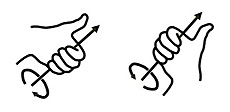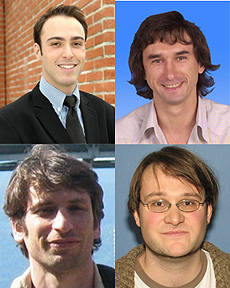Polarization of top quarks
 |
| "Lefty-tighty" (left) and "righty-tighty" (right). |
Disponible en español
Subatomic particles are like nuts and bolts. The old rule "righty-tighty" reminds us that a rotation like this (see above figure) causes a threaded object to move in that (tightening) direction.
Unless the threads are left-handed. There are a few places where left-handed threads are needed. For example, bicycle pedals will fall off without left-handed threads. In that case a rotation in the other direction will cause the threaded object to move in that same tightening direction.
Quarks, and indeed most subatomic particles, have a certain built-in intrinsic spin to them, just as they have a certain mass or electric charge. That spin can be either right- or left-handed. The difference is that rather than asking in which direction the screw will move when it is turned, we ask in which direction the quark moves relative to how it is turning. So, in the figure, if the quark moves to the right, the "righty-tighty" picture corresponds what we call a right-handed polarization. The "lefty-tighty" picture corresponds to what we call a left-handed polarization.
When top quarks were produced in the Tevatron, they should have had, according to the Standard Model, a small average polarization. On average, the polarization should be -0.19 percent, (0.19 percent to the left) with a margin of error of 0.05 percent; lefties and righties should be made in about equal quantities.
Here is why that matters: When a top quark and a top antiquark are produced by colliding a proton and antiproton, the direction of the top quark tends to be along the direction of the proton (see the July 3, 2014, issue of Fermilab Today). This "forward-backward asymmetry" has been a cause of excitement because early measurements were higher than expected. It turns out that the asymmetry has a strong dependence on the polarization. If either, or both, the asymmetry or the polarization is different from the expectation, that is a major discovery of new physics.
DZero has recently measured simultaneously the average polarization and the forward-backward asymmetry of top quarks created by the Tevatron. We find that the average polarization is righty, at +7.5 percent. But the margin of error in the measurement is 11.3 percent; the measurement is consistent with expectations. The asymmetry is 15.0 percent, with an 8.1 percent margin of error; that too is consistent with expectations.
Alas, no unexpected result that could lead to a major discovery is in evidence!
—Leo Bellantoni
 |
| Alexandre Faure, Slava Shary and Boris Tuchming (all of CEA, Irfu, SPP, Saclay, France) and Andreas Jung (Fermilab) are the primary analysts for this measurement. |
 |
| The DZero collaboration relies upon many of its collaborators to carefully review analyses for scientific quality before they are released. This analysis was guided by Editorial Board Chair Ken Bloom of the University of Nebraska, Lincoln. |
|